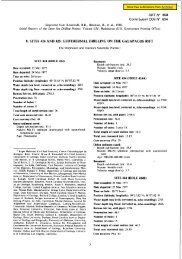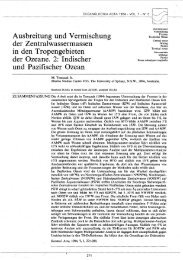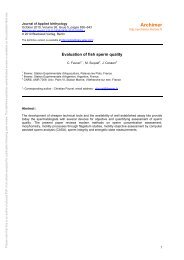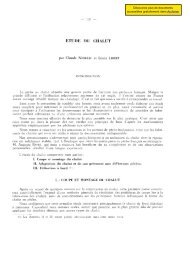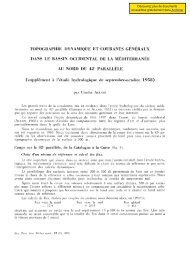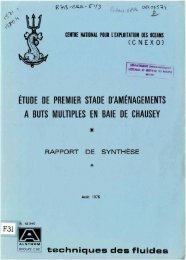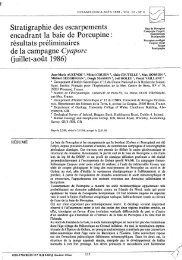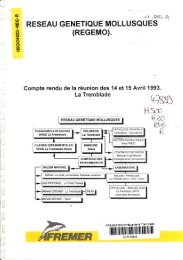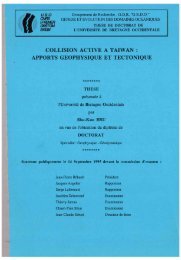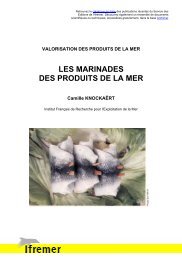- Page 1:
UNIVERSITE DE LA ROCHELLE UFR SCIEN
- Page 4 and 5:
Remerciements : Je tiens tout d’a
- Page 6 and 7:
(Ciboulette), Aurélien RIDE (Lapin
- Page 8 and 9:
Sapere aude (N’aie pas peur de sa
- Page 10 and 11:
6. REMERCIEMENTS. .................
- Page 12 and 13:
3. RESULTATS. .....................
- Page 14 and 15:
Introduction générale et contexte
- Page 16 and 17:
Introduction générale et contexte
- Page 18 and 19:
Introduction générale et contexte
- Page 20 and 21:
Introduction générale et contexte
- Page 22 and 23:
Introduction générale et contexte
- Page 24 and 25:
Introduction générale et contexte
- Page 26 and 27:
Introduction générale et contexte
- Page 28 and 29:
Introduction générale et contexte
- Page 30 and 31:
Introduction générale et contexte
- Page 32 and 33:
dorsal Face ventral Introduction g
- Page 34 and 35:
Introduction générale et contexte
- Page 36 and 37:
Otolithe d’un juvénile de l’an
- Page 38 and 39:
Introduction générale et contexte
- Page 40 and 41:
TOME 1 : Première partie. TOME 1 :
- Page 42 and 43:
TOME 1 : Première partie. Chapitre
- Page 44 and 45:
Chapitre 1 : Structuration du peupl
- Page 46 and 47:
Chapitre 1 : Structuration du peupl
- Page 48 and 49:
Chapitre 1 : Structuration du peupl
- Page 50 and 51:
Chapitre 1 : Structuration du peupl
- Page 52 and 53:
Chapitre 1 : Structuration du peupl
- Page 54 and 55:
Chapitre 1 : Structuration du peupl
- Page 56 and 57:
Chapitre 1 : Structuration du peupl
- Page 58 and 59:
Chapitre 1 : Structuration du peupl
- Page 60 and 61:
Chapitre 1 : Structuration du peupl
- Page 62 and 63:
Chapitre 1 : Structuration du peupl
- Page 64 and 65:
Chapitre 1 : Structuration du peupl
- Page 66 and 67:
Chapitre 1 : Structuration du peupl
- Page 68 and 69:
Chapitre 1 : Structuration du peupl
- Page 70 and 71:
Chapitre 2 : Evolution des assembla
- Page 72 and 73:
Chapitre 2 : Evolution des assembla
- Page 74 and 75: Chapitre 2 : Evolution des assembla
- Page 76 and 77: Chapitre 2 : Evolution des assembla
- Page 78 and 79: Chapitre 2 : Evolution des assembla
- Page 80 and 81: Chapitre 2 : Evolution des assembla
- Page 82 and 83: Chapitre 2 : Evolution des assembla
- Page 84 and 85: Chapitre 2 : Evolution des assembla
- Page 86 and 87: Chapitre 2 : Evolution des assembla
- Page 88 and 89: Chapitre 2 : Evolution des assembla
- Page 90 and 91: Chapitre 2 : Evolution des assembla
- Page 92 and 93: Chapitre 2 : Evolution des assembla
- Page 94 and 95: Chapitre 3 : Les nourriceries ligé
- Page 96 and 97: Chapitre 3 : Les nourriceries ligé
- Page 98 and 99: 3. Résultats. Chapitre 3 : Les nou
- Page 100 and 101: Chapitre 3 : Les nourriceries ligé
- Page 102 and 103: Chapitre 3 : Les nourriceries ligé
- Page 104 and 105: Chapitre 3 : Les nourriceries ligé
- Page 106 and 107: Chapitre 3 : Les nourriceries ligé
- Page 108 and 109: Chapitre 3 : Les nourriceries ligé
- Page 110 and 111: Chapitre 3 : Les nourriceries ligé
- Page 112 and 113: Chapitre 3 : Les nourriceries ligé
- Page 114 and 115: Chapitre 3 : Les nourriceries ligé
- Page 116 and 117: Chapitre 3 : Les nourriceries ligé
- Page 118 and 119: Chapitre 4 : Impact of vegetation s
- Page 120 and 121: Chapitre 4 : Impact of vegetation s
- Page 122 and 123: Chapitre 4 : Impact of vegetation s
- Page 126 and 127: Chapitre 4 : Impact of vegetation s
- Page 128 and 129: Chapitre 4 : Impact of vegetation s
- Page 130 and 131: Chapitre 4 : Impact of vegetation s
- Page 132 and 133: Chapitre 4 : Impact of vegetation s
- Page 134 and 135: Chapitre 4 : Impact of vegetation s
- Page 136 and 137: Chapitre 4 : Impact of vegetation s
- Page 138 and 139: Chapitre 4 : Impact of vegetation s
- Page 140 and 141: Chapitre 4 : Impact of vegetation s
- Page 142 and 143: Chapitre 4 : Impact of vegetation s
- Page 144 and 145: TOME 1 : Seconde partie. Seconde pa
- Page 146 and 147: Guildes colonisatrices, contextes m
- Page 148 and 149: Guildes colonisatrices, contextes m
- Page 150 and 151: Guildes colonisatrices, contextes m
- Page 152 and 153: Guildes colonisatrices, contextes m
- Page 154 and 155: Guildes colonisatrices, contextes m
- Page 156 and 157: Guildes colonisatrices, contextes m
- Page 158 and 159: Guildes colonisatrices, contextes m
- Page 160 and 161: Guildes colonisatrices, contextes m
- Page 162 and 163: Guildes colonisatrices, contextes m
- Page 164 and 165: Guildes colonisatrices, contextes m
- Page 166 and 167: Guildes colonisatrices, contextes m
- Page 168 and 169: Guildes colonisatrices, contextes m
- Page 170 and 171: Guildes colonisatrices, contextes m
- Page 172 and 173: Conclusion. TOME1 : Conclusion Dans
- Page 174 and 175:
TOME1 : Conclusion exergue par les
- Page 176 and 177:
Introduction. TOME 2 : Introduction
- Page 178 and 179:
TOME 2 : Introduction. indiquer la
- Page 180 and 181:
1.1. Description du cycle biologiqu
- Page 182 and 183:
TOME 2 : Introduction. de répartit
- Page 184 and 185:
Efficacité de la nourricerie éval
- Page 186 and 187:
Chapitre 1 : Variations régionales
- Page 188 and 189:
Chapitre 1 : Variations régionales
- Page 190 and 191:
Chapitre 1 : Variations régionales
- Page 192 and 193:
Chapitre 1 : Variations régionales
- Page 194 and 195:
Chapitre 1 : Variations régionales
- Page 196 and 197:
Chapitre 1 : Variations régionales
- Page 198 and 199:
Chapitre 1 : Variations régionales
- Page 200 and 201:
Chapitre 2 : Les marais salés cont
- Page 202 and 203:
Chapitre 2 : Les marais salés cont
- Page 204 and 205:
Chapitre 2 : Les marais salés cont
- Page 206 and 207:
Chapitre 2 : Les marais salés cont
- Page 208 and 209:
Chapitre 2 : Les marais salés cont
- Page 210 and 211:
Chapitre 2 : Les marais salés cont
- Page 212 and 213:
15N depleted δ15N‰ 15N enriched
- Page 214 and 215:
Chapitre 2 : Les marais salés cont
- Page 216 and 217:
Chapitre 2 : Les marais salés cont
- Page 218 and 219:
TOME 2 : Chapitre 3 Chapitre 3 : Di
- Page 220 and 221:
Chapitre 3 : Discrimination de quat
- Page 222 and 223:
Chapitre 3 : Discrimination de quat
- Page 224 and 225:
Chapitre 3 : Discrimination de quat
- Page 226 and 227:
Chapitre 3 : Discrimination de quat
- Page 228 and 229:
Chapitre 3 : Discrimination de quat
- Page 230 and 231:
Chapitre 3 : Discrimination de quat
- Page 232 and 233:
TOME 2 : Chapitre 4 44 : Concentrat
- Page 234 and 235:
Chapitre 4 : Reconstitution de l’
- Page 236 and 237:
Chapitre 4 : Reconstitution de l’
- Page 238 and 239:
Chapitre 4 : Reconstitution de l’
- Page 240 and 241:
Chapitre 4 : Reconstitution de l’
- Page 242 and 243:
Chapitre 4 : Reconstitution de l’
- Page 244 and 245:
Chapitre 4 : Reconstitution de l’
- Page 246 and 247:
Chapitre 4 : Reconstitution de l’
- Page 248 and 249:
Chapitre 4 : Reconstitution de l’
- Page 250 and 251:
Chapitre 4 : Reconstitution de l’
- Page 252 and 253:
Conclusion générale et perspectiv
- Page 254 and 255:
Conclusion générale et perspectiv
- Page 256 and 257:
Conclusion générale et perspectiv
- Page 258 and 259:
Conclusion générale et perspectiv
- Page 260 and 261:
Littérature citée. Bibliographie.
- Page 262 and 263:
Bibliographie. Charnov, E. L. et J.
- Page 264 and 265:
Bibliographie. Fritsch, M. et Y. Mo
- Page 266 and 267:
Bibliographie. Kneib, R. T. (1995).
- Page 268 and 269:
Bibliographie. Maitland, P. S. (197
- Page 270 and 271:
Bibliographie. Ecobio 6553, Muséum
- Page 272 and 273:
Bibliographie. Secor, D. H. (2002).
- Page 274 and 275:
Annexes : Annexe 1 : Description de
- Page 276 and 277:
Annexe 2 : Curriculum vitae. Emmanu
- Page 278 and 279:
Annexes. 2001 Stagiaire: Universit
- Page 280 and 281:
Annexes. Parlier E., Duhamel S., Fe
- Page 282:
Résumé Approche quantitative de l



